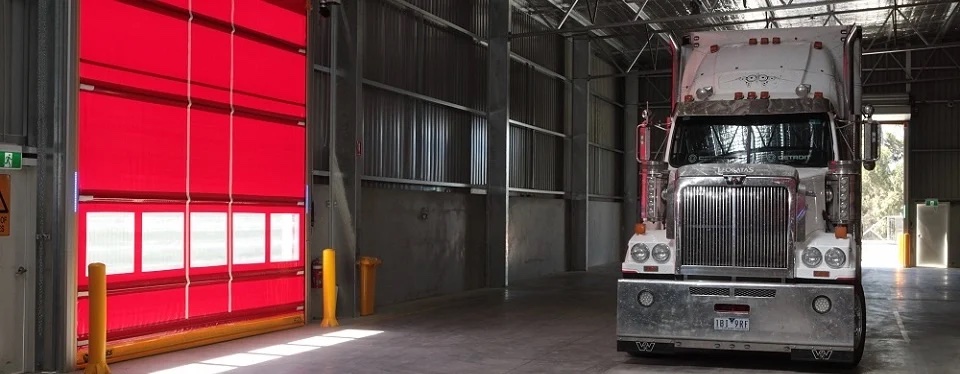Rapid Roller Doors
Fast, robust and tough enough to handle any traffic
If your warehouse or industrial facility features high traffic doorways that need to consistently keep a tight seal, rapid roller doors are the ideal solution. Available in a range of speeds, rapid roller doors (also called high speed doors) can be custom-made to suit the particular needs of your facility.

Rapid roller doors control airflow while allowing fast and easy access
High speed or rapid doors are ideal for applications including:
- Controlling temperatures, such as in freezers or cool rooms
- Preventing dust, such as in warehouses, production areas, or packing sheds
- Controlling bacteria, such as for pharmaceutical, hospital, or food and beverage applications, and
- Handling traffic, such as providing fast, reliable access to supermarket stock rooms whilst preventing public access.
Download your brochure: the full range of high speed rapid doors
How quickly do rapid roller doors open and close?
While rapid doors can open and close at 2 to 2.5 metres per second, their speed is largely influenced by the opening size and the environment (whether external or internal) in which it’s installed.
For example, a smaller internal door that deals only with low air pressure can have fibreglass (GRP) battens and will open quickly. On the other hand, a larger external door exposed to wind will need to be more robust (with more mass), and therefore will need to run a little more slowly.
What materials are rapid doors made from?
The curtain element of a rapid roller door is made from PVC coated polyester as standard, to ensure lightness, flexibility, and durability.
When used for cold rooms, a foam backing can be added to provide insulation. And for freezers, rapid doors can be supplied with two layers of foam inside two layers of PVC for even more insulation.
The framework of rapid roller doors, including tracks and covers, is usually made from anodized aluminium. Or, if your business operates in a caustic environment (such as utilising harsh wash-down chemicals) it may be appropriate to manufacture rapid doors from stainless steel. In applications where hygiene is an issue (such as for bacteria control, or in a hospital environment), stainless steel also offers an easy-to-clean non-porous surface.
When choosing a rapid door, ensure it has motors and controllers that are engineered for a high duty cycle for quality and durability. It’s also a good idea to look for a supplier that offers parts replacement with warranty support to minimise potential downtime.
Safety features to look for in a high speed or rapid roller door
Detection sensors (such as a PE (photoelectric) beam or light curtain can be integrated into the rapid door to ensure safe operation. The sensor will automatically sense when a person or forklift approaches, and seamlessly retract the high speed door.
Can rapid roller doors deal with impacts?
In an industrial or warehouse environment, collisions between forklifts or trolleys and doors are a fact of life. That’s why it’s important to look for a rapid door that has been engineered with impacts in mind.
Rapid roller doors can be cleverly designed to ‘let go’ rather than resist impacts. This ‘self-repair’ function means the door pops out of its frame, then realigns back in its tracks as it continues to roll up.
Since no repairs are needed, there’s no down time for your warehouse, and business can continue as usual.
See it in action now:
Are rapid roller doors suitable for high wind areas?
For external applications where there is a high wind load, rapid roller doors can be designed and manufactured with integrated wind battens to suit the wind pressure in that environment.
However, if very high pressure is likely, then folding rapid roller doors should be considered as an option. This is because the balance between “crash out and self-repair” and the wind loads means the rapid door’s self-repair capability may have to be reduced.
Download your brochure: the full range of high speed rapid doors
Can high speed doors be used for security?
While rapid roller doors are not strictly a security door, that doesn’t rule out their use on the exterior of your facility. When set up in tandem with a steel roller shutter, they can provide the necessary temperature and/or dust control during the day, whilst the shutter provides after hours security. Pedestrian access can then be arranged either via a swipe card or fob, or by incorporating another system.
How are high speed doors activated?
Rapid roller doors can be activated with a variety of systems, including:
- Radar -smart sensing of vehicle traffic, and discriminating the traffic you don’t want detected such as cross-traffic, pedestrians, birds.
- Infrared -presence sensing to hold doors open when an object is still in the opening
- Push button
- Touchless hand sensor
- Remote control
- Floor loops -inductive sensors which sense metallic objects, similar to what is used at traffic lights
- Swipe card or fob for secure access
These sensors can be specifically located with widely adjustable parameters to suit the environment and the sensing distance from the rapid door. That way, they can sense when a vehicle is between 2 and 8 metres away, and automatically open. This distance can be customised and set to your individual traffic flow requirements.
Choose high quality, Australian made rapid roller doors
Remax Doors proudly manufactures our high quality rapid roller doors here in Australia. This means we can deliver your rapid doors with a fast lead time, and we have complete control over the production process to ensure quality.
If you need a custom rapid roller door, we will be happy to be flexible with our designs to deliver exactly what you need. And with our factory located in Australia, parts replacement and support are never far away.







